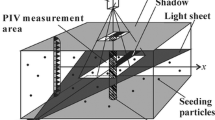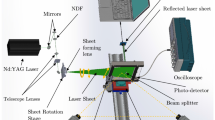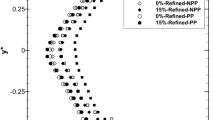Abstract
The effect of mismatched or misaligned laser light sheet profiles on the quality of particle image velocimetry (PIV) results is considered in this study. Light sheet profiles with differing widths, shapes, or alignment can reduce the correlation between PIV images and increase experimental errors. Systematic PIV simulations isolate these behaviours to assess the sensitivity and implications of light sheet mismatch on measurements. The simulations in this work use flow fields from a turbulent boundary layer; however, the behaviours and impacts of laser profile mismatch are highly relevant to any fluid flow or PIV application. Experimental measurements from a turbulent boundary layer facility are incorporated, as well as additional simulations matched to experimental image characteristics, to validate the synthetic image analysis. Experimental laser profiles are captured using a modular laser profiling camera, designed to quantify the distribution of laser light sheet intensities and inform any corrective adjustments to an experimental configuration. Results suggest that an offset of just 1.35 standard deviations in the Gaussian light sheet intensity distributions can cause a 40% reduction in the average correlation coefficient and a 45% increase in spurious vectors. Errors in measured flow statistics are also amplified when two successive laser profiles are no longer well matched in alignment or intensity distribution. Consequently, an awareness of how laser light sheet overlap influences PIV results can guide faster setup of an experiment, as well as achieve superior experimental measurements.













Similar content being viewed by others
Notes
The final form of the modified \(F_\text {O}\) expression shown here was developed in collaboration with Sven Scharnowski and Christian Kähler from Bundeswehr University, Munich, after the initial submission of this article. It is comprehensively outlined in Scharnowski et al. (2017).
References
Adrian RJ, Westerweel J (2011) Particle image velocimetry. Cambridge University Press, Cambridge
Andrèbe Y, Behn R, Duval BP, Etienne P, Pitzschke A (2011) Use of webcams as tools for alignment and supervision of a Thomson scattering system in the near infrared. Fusion Eng Des 86(6):1273–1276
Blinde PL, Lynch KP, Schrijer FFJ, Van Oudheusden BW (2015) Determination of instantaneous pressure in a transonic base flow using four-pulse tomographic PIV. In: 11th International Symposium on Particle Image Velocimetry
Brücker C, Hess D, Kitzhofer J (2012) Single-view volumetric PIV via high-resolution scanning, isotropic voxel restructuring and 3D least-squares matching (3D-LSM). Meas Sci Technol 24(2):024001
Cignoli F, De Iuliis S, Zizak G (2004) A webcam as a light probe beam profiler. Appl Spectrosc 58(11):1372–1375
Coffin D (2008) DCRAW: Decoding raw digital photos in Linux
de Silva CM, Baidya R, Khashehchi M, Marusic I (2012) Assessment of tomographic PIV in wall-bounded turbulence using direct numerical simulation data. Exp Fluids 52(2):425–440
de Silva CM, Squire DT, Hutchins N, Marusic I (2015) Towards capturing large scale coherent structures in boundary layers using particle image velocimetry. In: 7th Australian Conference on Laser Diagnostics in Fluid Mechanics and Combustion
Elsinga GE, Van Oudheusden BW, Scarano F (2006) Experimental assessment of tomographic-PIV accuracy. In: 13th International Symposium on Applications of Laser Techniques to Fluid Mechanics
Fond B, Abram C, Beyrau F (2015) On the characterisation of tracer particles for thermographic particle image velocimetry. Appl Phys B 118(3):393–399
Ganapathisubramani B, Longmire EK, Marusic I, Pothos S (2005) Dual-plane PIV technique to determine the complete velocity gradient tensor in a turbulent boundary layer. Exp Fluids 39(2):222–231
Grayson K, de Silva CM, Hutchins N, Marusic I (2017) Beam stability and warm-up effects of Nd:YAG lasers used in particle image velocimetry. Meas Sci Technol 28(6):065301
Kähler CJ, Kompenhans J (2000) Fundamentals of multiple plane stereo particle image velocimetry. Exp Fluids 29(1):S070–S077
Keane RD, Adrian RJ (1992) Theory of cross-correlation analysis of PIV images. Appl Sci Res 49(3):191–215
Langer G, Hochreiner A, Burgholzer P, Berer T (2013) A webcam in Bayer-mode as a light beam profiler for the near infra-red. Optics Lasers Eng 51(5):571–575
Lewis JP (1995) Fast normalized cross-correlation. Vis Interface 10:120–123
Mistry D, Dawson J (2014) Experimental investigation of multi-scale entrainment processes of a turbulent jet. In: 17th International Symposium on Applications of Laser Techniques to Fluid Mechanics
Mullin JA, Dahm WJA (2005) Dual-plane stereo particle image velocimetry (DSPIV) for measuring velocity gradient fields at intermediate and small scales of turbulent flows. Exp Fluids 38(2):185–196
Naka Y, Tomita K, Shimura M, Fukushima N, Tanahashi M, Miyauchi T (2016) Quad-plane stereoscopic PIV for fine-scale structure measurements in turbulence. Exp Fluids 57(5):1–20
Nickels TB, Marusic I, Hafez S, Chong MS (2005) Evidence of the -1-law in a high-Reynolds-number turbulent boundary layer. Phys Rev Lett 95(7):074501
Nobach H (2011) Influence of individual variations of particle image intensities on high-resolution PIV. Exp Fluids 50(4):919–927
Nobach H, Bodenschatz E (2009) Limitations of accuracy in PIV due to individual variations of particle image intensities. Exp Fluids 47(1):27–38
Pfadler S, Dinkelacker F, Beyrau F, Leipertz A (2009) High resolution dual-plane stereo-PIV for validation of subgrid scale models in large-eddy simulations of turbulent premixed flames. Combust Flame 156(8):1552–1564
Scarano F, Elsinga GE, Bocci E, van Oudheusden BW (2006) Investigation of 3-D coherent structures in the turbulent cylinder wake using tomo-PIV. In: 13th International Symposium on Applications of Laser Techniques to Fluid Mechanics
Scharnowski S, Kähler CJ (2016) Estimation and optimization of loss-of-pair uncertainties based on PIV correlation functions. Exp Fluids 57(2):1–11
Scharnowski S, Grayson K, de Silva CM, Hutchins N, Marusic I, Kähler CJ (2017) Generalization of the PIV loss-of-correlation formula introduced by Keane and Adrian. Exp Fluids 58(10):150
Sillero JA, Jiménez J, Moser RD (2013) One-point statistics for turbulent wall-bounded flows at Reynolds numbers up to \(\delta +\) 2000. Phys Fluids 25(10):105102
Westerweel J (1993) Digital particle image velocimetry. PhD thesis, Delft University
Westerweel J (2000) Theoretical analysis of the measurement precision in particle image velocimetry. Exp Fluids 29(1):S003–S012
Westerweel J, Scarano F (2005) Universal outlier detection for PIV data. Exp Fluids 39(6):1096–1100
Wieneke B (2005) Stereo-PIV using self-calibration on particle images. Exp Fluids 39(2):267–280
Worth NA, Nickels TB, Swaminathan N (2010) A tomographic PIV resolution study based on homogeneous isotropic turbulence DNS data. Exp Fluids 49(3):637–656
Acknowledgements
The authors wish to thank the Australian Research Council and the Australian Government Research Training Program Scholarship for their financial support of this research.
Author information
Authors and Affiliations
Corresponding author
Appendix
Appendix
A low-cost laser profiling camera using readily available off-the-shelf components is used in this study to capture laser behaviours. This appendix outlines the components of the camera design and the procedure for its use in PIV measurements.
1.1 Camera configuration
The laser profiling system uses a mirrorless interchangeable lens camera with a large APS-C size sensor measuring \(22.3 \times 14.9\) mm2, able to comfortably fit the unfocused laser beams used in typical PIV experiments. A Canon EOS-M camera body is used for this purpose (no lens is required), containing an 18 megapixel sensor that results in a pixel density of \(\sim \)230 px/mm (see ⑤ in Fig. 14a). We note that more conventional digital single-lens reflex (SLR) cameras have also been tested with success. A wired remote trigger is used with a Wi-Fi enabled SD card to remotely capture and review images in near real-time (some cameras may also allow USB tethered image capture). An overview of this setup is shown in Fig. 14b.
Laser profiling camera setup a annotated top view and b perspective view. Annotations in a denote ① the laser-grade neutral density filter, ② laser-grade filter threaded adapter, ③ photographic neutral density filters, ④ 3D printed camera lens mount with epoxied metal filter thread, ⑤ interchangeable lens camera body
Due to the sensitive electronics found in digital cameras, attenuation optics are needed to image a laser profile without damaging the camera sensor. These optics also require the flexibility to adjust filter strength to tune image exposure for different setups and laser powers. In this study, as with prior published works (Cignoli et al. 2004; Langer et al. 2013), neutral density filters are used to achieve the necessary attenuation. These optics are commonly available with threaded mounts and in a variety of strengths to be stacked, mixed, and matched. The laser profiling setup uses a combination of laser-grade neutral density filters and standard photographic neutral density filters used for still photography. Laser-grade neutral density filters are ideal for this application, purpose built to take the energy densities found in laser profiling. Photographic neutral density filters, however, have the advantage of being inexpensive and readily available in a variety of filter strengths. They are also capable of withstanding a surprising amount of laser energy, although it should be noted that a gradual change in filter characteristics has been observed over long term use. The profiling setup in this study uses a variety of photographic neutral density filters of different strengths (③ in Fig. 14a), and a laser-grade neutral density filter is added to the top of the filter stack via a threaded adapter (① and ② in Fig. 14a) when profiling higher energy laser beams (such as 400 mJ/pulse 532 nm beams).
These filters thread onto a metal filter step ring that is epoxied to a 3D printed camera lens mount (④ in Fig. 14a). This mount locks into the camera as required and angles the filters off the sensor plane to prevent any laser reflections returning through the beam path into the laser unit and causing damage. The solid green line in Fig. 14a shows the incident path of a sampled laser beam and the dotted green line indicates the direction of any surface reflections off the neutral density filters.
Since this camera contains an RGB colour imaging sensor (using a Bayer filter array), only the most relevant interpolated colour channel is considered in analysis; for example, the green channel is isolated when imaging 532 nm lasers. Laser profile features of significance are typically on the order of 0.1–1 mm, much larger than the 0.0043 mm pixel size of the imaging sensor. Therefore, Bayer filter interpolation effects are considered to have a negligible impact on results and spatially interpolated RAW camera images are captured for laser profile analysis. Consumer cameras also incorporate a non-linear pixel brightness behaviour (defined by the gamma correction factor, \(\gamma \)) into processed images by default, to mimic the non-linear interpretation of brightness by the human eye. RAW images must, therefore, be processed with a gamma correction, where \(\gamma = 1\), to ensure a linear brightness response. To achieve this, the DCRaw software package (Coffin 2008) is used to process the RAW camera images and ensure that the resulting TIFF image files contain the corrected linear brightness response for quantitative analysis.
Figure 15a shows a sample laser beam profile captured with the device. We note that the pattern of concentric rings is due to thermal lensing within the cavity and is considered typical of this particular Nd:YAG laser. However, a slight asymmetry of the beam can also be identified in this image which would have been difficult to observe in many burn tests, where the top of the profile is slightly brighter than the bottom. Although these asymmetries are often overlooked, they can have significant consequences when the beam is spread into a laser sheet for PIV, causing asymmetric or multi-lobed laser sheet profiles. These irregular profiles can make profile matching of the two PIV laser beams more difficult. Figure 15b shows a laser sheet profile from a similar 532 nm Nd:YAG laser.
1.2 Camera applications
This laser profiling camera has numerous potential applications for laser tuning, diagnostics, and experimental setup. Profiling a laser beam can reveal non-uniformities in the beam profile, overlap issues and potential faults in the laser unit. Regular measurements of beam profiles can also monitor incremental degradation of laser performance and inform service schedules for laser equipment. Dynamic laser behaviours such as the time required for the laser to warm up and reach thermal equilibrium from a cold start, or shot-to-shot beam stability have been recognised as important factors when performing PIV experiments (Kähler and Kompenhans 2000; Fond et al. 2015; Grayson et al. 2017). A camera-based laser profiler, such as the device discussed in this study, is capable of quantifying and monitoring these behaviours in a given laser unit.
Laser light sheets can also be profiled with this device (see Fig. 15b), and these measurements can be crucial to ensuring well-matched laser sheet profiles for PIV images. The alignment and intensity distributions of the light sheet can be quantified across the measurement region to optimise PIV image quality over the entire field of view.
Furthermore, this laser profiling system is not restricted to use with PIV equipment, and can be used in a large range of experiments involving laser devices. Tests with this setup have also been performed on a Laser Doppler Anemometry system to verify laser crossover locations and symmetry, beam stability, and profiles. To date, this device has captured data from 120 mJ/pulse up to 400 mJ/pulse Nd:YAG 532 nm pulsed PIV lasers, as well as continuous 12 W 485–529 nm Argon Ion, \(\sim \,\) 90 mW 660 nm red diode and 785 nm infrared diode laser beams.
Rights and permissions
About this article
Cite this article
Grayson, K., de Silva, C.M., Hutchins, N. et al. Impact of mismatched and misaligned laser light sheet profiles on PIV performance. Exp Fluids 59, 2 (2018). https://doi.org/10.1007/s00348-017-2453-4
Received:
Revised:
Accepted:
Published:
DOI: https://doi.org/10.1007/s00348-017-2453-4






